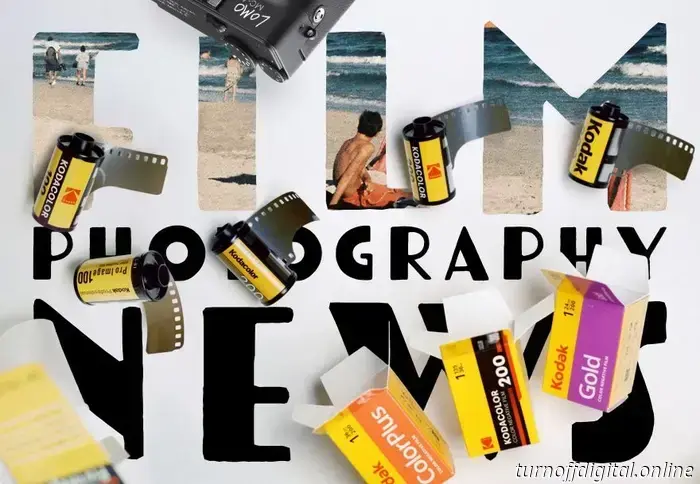
☞ This is the 79th issue of the monthly Analog.Cafe Newsletter, bringing you the latest news in film photography. Subscribe to receive it via email on the last Tuesday of each month (it’s free). The prominent highlights in the film photography realm this October include new Kodak films and a fresh point-and-shoot camera from Lomography. Additionally, there’s plenty more — from yet another new color film (from Lomography) to a gold-plated WideluxX prototype and several remarkable community initiatives. This free and ad-free newsletter is made possible by our GOLD members. Members have access to more articles, such as “How to Edit Film Scans” and “Pushing Ilford HP5+ to ISO 100,000,” as well as apps like film Q for inverting film negatives online. This month, I’ve included a practical guide on creating pinhole cameras, ranging from a five-minute project to multi-month ventures. 🎁 Try GOLD free for 14 days — and you might even win free film! In this newsletter: Free film. Kodak Kodacolor? What’s that? A podcast discussing Kodak's business aspects. Lomo MC-A. Lomochrome Classicolor 200. WideluxX. Jagglé daylight development cassettes. Fixing expired film scans. Availability of Lucky 200 film. Upcoming film products and projects. I created a film camera from a pumpkin and captured a haunted “selfie.” 🎃 Latest updates on Analog.Cafe. Support this blog & enjoy premium features with GOLD memberships! Free film. Throughout the summer and fall, I’ve been giving away film to GOLD members at the end of each month. This is the announcement for the October giveaway. Only two more chances left before I run out! The recipient of the triple-pack hand-wound black-and-white film (from Ilford), Cinema Shorts BW 200 and Cinema Shorts BW 3200, is: 🎈Michael, 🎈Congratulations! You’ve won three rolls of free Cinema Shorts film. I’ve emailed you with the next steps. The next winner will be announced in the coming month. Learn more. If that’s not you, but you’re still interested in trying the film and supporting the blog, it can be purchased in the shop (with optional lab services). I only have a limited number of rolls available. The film is packed in upcycled metal cartridges and plastic canisters, accompanied by a brief, home-printed brochure, all in 100% plastic-free padding within a recycled-paper cardboard box. TL;DR: Kodak has re-released some of its existing films as Kodacolor 100 & Kodacolor 200 (equivalent to ColorPlus 200). While not entirely new, these films should provide a better deal for film photographers. Kodak Kodacolor? What’s that? Kodak was a giant in the industry. However, after much of the market shifted to digital cameras around the 2010s, the business downsized significantly. Though Kodak was too substantial to fail, it nevertheless became much smaller. Currently, most of its revenue comes from supplying commercial printers. Film still comprises only a small fraction of Kodak’s total income, but the company is investing in it. Factory upgrades are crucial for various reasons. Kodacolor, however, signals a different type of investment. It indicates that Kodak is taking control of its distribution, which may lead to lower film prices in the near future. How is this possible in a world where everything seems to be getting pricier? The relief could manifest in the form of alleviating the “Alaris tax”: allow me to elaborate. Kodak Alaris became a separate entity following Kodak’s bankruptcy in 2012. For the last 13 years, it has functioned independently from Eastman Kodak Company. Eastman Kodak Company is what most people think of when mentioning Kodak. It’s the part of the business responsible for the factory in Rochester, New York, where film is produced. Despite its separation from the factory, Alaris retained the distribution rights for Kodak film. Therefore, once the Kodak-branded film leaves the Rochester factory, Alaris assumes responsibility for marketing and distribution as a third-party partner. However, starting this month, Eastman Kodak will begin distributing some films directly without third-party involvement (Alaris). Kodacolor 100 and Kodacolor 200 are the two films now distributed directly by Eastman Kodak Company. It is anticipated that the removal of a third party will reduce the prices of these two films compared to their current counterparts. So, what are those counterparts? I have yet to validate the theory that “Kodacolor 100 is Pro Image 100,” but I am reasonably certain that Kodacolor 200 is identical to ColorPlus 200 (refer to my test results and learn about my methods for conducting film comparisons). A podcast about the business side of Kodak. If you're interested in understanding more about Kodak's
The major highlights in the realm of film photography this October include the latest Kodak films and a newly released point-and-shoot camera from Lomography. Additionally, there's much more to explore — including another new color film (also from Lomography), a gold-plated (?) WideluxX prototype, and several remarkable community initiatives.